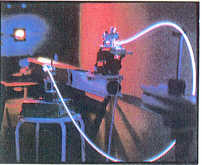
OSN Executive Editor
ORLANDO-An excimer laser operating at 308 nm through a fiber-optic probe has been used sucessfully to "phacoablate" or "photodecompose" the lenses of various animals and postmortem human eyes.
Used through a 1-mm incision in the eye, the system may one day permit an endocapsular cataract extraction that is "less stressful to the zonules" and "technically easier" to perform than endocapsular phacoemulsification, according to investigator Patricia E. Bath,MD, who described her research here in a presentation at the Symposium on Cataract, IOL and Refractive Surgery sponsored by the American Society of Cataract and Refractive Surgery.
Excimer laser phacoablation, Bath predicted, may one day be used in several ways: to ablate the lens prior to standard phacoemulsification, which would require that the 1-mm incision be enlarged to accomodate the 3-mm phaco tip; to ablate the lens to the point where it could be removed with simple irrigation/aspiration; or to remove the cataract with what Bath calls "laserphaco," a laser probe that includes irrigation/ aspiration. Such a probe is now in the prototype stage, said Bath, who is associate professor of ophthalmology, Jules Stein Eye Institute, University of California at Los Angeles.

It appears to work better on
humanlenses than the animal
lenses that I used... The human
lens becomes more UV-absorbing
the older it is.
- Patricia Bath
 Experimental set-up: the glowing quartx silica optical fiber of the Lambda Physik 102 xenon chloride excimer laser snakes around its laboratory location. A laser-I/A probe for humans is in prototype.
Experimental set-up: the glowing quartx silica optical fiber of the Lambda Physik 102 xenon chloride excimer laser snakes around its laboratory location. A laser-I/A probe for humans is in prototype.Animal models
"It appears to work better on human lenses than the animal lenses that I used," Bath said. "That's probably logical. The animal eyes that I tested were younger; the human globes were from individuals over the age of 50. The human lens became more UV-absorbing the older it is. That worked to the advantage of the experiment."
Apple's histopathology showed "a totally new finding," Bath noted, "a denaturation and laser liquefaction of lens material. This is not described before."
Background research
Beginning the research in October 1986, Bath used a Lambda Physik 102 xenon chloride excimer laser working through a quartz silica optical fiber in rabbit, porcine and bovine globes and in human postmortem eyes. "I was able to transmit the radiation through the optical fiber at 308 nm with no problem whatsoever." The excimer laser wavelength of 193 nm, which is generally considered the most desirable for corneal ablation, is more dificult to transmit through optical fibers, Bath explained, though it can be done. There is no consensus and little evidence of what the optimun wavelength might be for the human lens, she noted.
With sufficient funding, the technology to remove human cataracts with an excimer laser probe could be ready for clinical observations within a year, Bath said. She is continuing research on the procedure at the University of California, Los Angeles, and at the Beckman Laser Institute. A multicenter collaborative investigative study is currently in the planning stages.